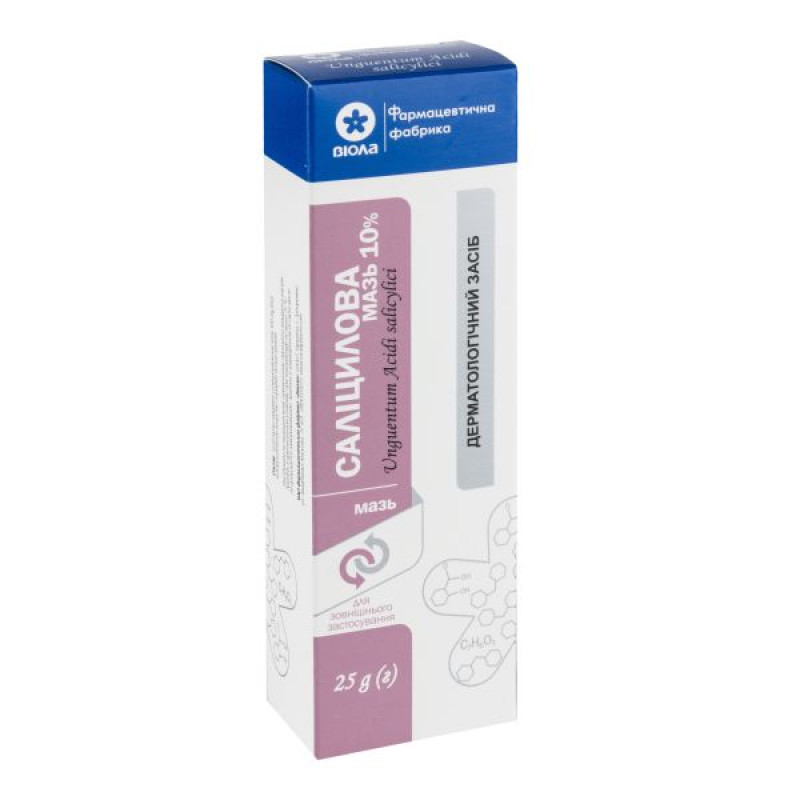Salicylic ointment 10% tube 25 g

Instructions Salicylic ointment 10% tube 25 g
Composition
active ingredient: salicylic acid;
1 g of ointment contains salicylic acid 20 mg or 50 mg or 100 mg;
excipient: white soft paraffin.
Dosage form
Ointment.
Main physicochemical properties: homogeneous ointment of white or light yellow color.
Pharmacotherapeutic group
Dermatological products. Salicylic acid preparations.
ATX code D02AF.
Pharmacological properties
Pharmacodynamics.
Salicylic acid, when applied topically, exhibits a weak antiseptic, as well as an irritating, distracting effect. It inhibits the secretion of sebaceous and sweat glands. In low concentrations, it exhibits a keratoplastic effect, and in high concentrations, it exhibits a keratolytic effect.
Pharmacokinetics.
Salicylic ointment should be applied externally; it is practically not absorbed into the systemic bloodstream and does not exhibit a resorptive effect.
Indication
Ointment 2% and 5%: topical treatment of large-area hyperkeratosis (e.g. psoriasis).
Ointment 10%: topical treatment of warts and calluses.
Contraindication
Hypersensitivity to salicylic acid.
Special safety precautions
Do not allow the drug to get into the eyes, do not apply to mucous membranes.
Interaction with other medicinal products and other types of interactions
When used simultaneously with drugs for external use, new compounds with unpredictable effects may be created, which requires consultation with a doctor.
Topical application of salicylic acid should not be combined with oral use of preparations containing acetylsalicylic acid and other nonsteroidal anti-inflammatory drugs. Do not use with benzoyl peroxide and topical retinoids.
Salicylic acid may increase the skin permeability of other topical medications and thereby increase their absorption into the body. In addition, salicylic acid may enhance the undesirable effects of methotrexate and the hypoglycemic effects of oral sulfonylurea antidiabetic drugs.
If the patient is taking any other medications, it is imperative to inform the doctor.
Application features
The drug should not be applied to large areas of skin.
Use during pregnancy or breastfeeding
The safety and clinical efficacy of the drug during pregnancy or breastfeeding have not been studied.
The ability to influence the reaction speed when driving or working with other mechanisms
The effect of the drug on the ability to drive vehicles and other mechanisms has not been described.
Method of administration and doses
Before applying a bandage with salicylic ointment, free the wound from necrotic masses and wash it with an antiseptic solution.
Apply the ointment to the affected areas 2-3 times a day with a sterile napkin or apply a sterile bandage soaked in ointment to the wounds.
For severe inflammation, dilute 2% ointment with petroleum jelly in a ratio of 1:2 – 1:4 and apply 1-2 times a day; after eliminating peeling, use other products.
To treat warts and calluses, use 10% ointment.
The duration of the treatment course is from 6 to 20 days.
Children
Experience with use in children has not been described.
Overdose
The ointment is intended for external use only. When taken internally, heartburn and pain occur along the esophagus and in the stomach, repeated vomiting, which may be mixed with blood, sometimes - loose stools mixed with blood. Patients are excited, in a state of euphoria. Dizziness, tinnitus, hearing loss, visual impairment appear. Breathing is loud, rapid.
Treatment: gastric lavage through a probe, forced diuresis, administration of a significant amount of alkaline fluid.
When using large doses of the drug, the keratolytic effect and allergic reactions may increase. In this case, the drug should be washed off with water and a doctor should be consulted. Therapy is symptomatic.
Side effects
Rarely - local reactions in the form of itching, burning, skin rashes, dryness, peeling, irritation, contact dermatitis, urticaria.
With prolonged use, absorption of the drug into the general bloodstream and the development of side effects typical of salicylates are possible: tinnitus, dizziness, epigastric pain, nausea, vomiting, acidosis, rapid breathing.
If any adverse reactions occur, you should consult a doctor!
Expiration date
3 years.
Storage conditions
Store in the original packaging at a temperature not exceeding 25 °C; do not freeze. Keep out of the reach of children.
Packaging
25 g containers. 20 g or 25 g in tubes. 1 tube in a pack or without a pack.
Vacation category
Without a prescription.
Producer
PrJSC Pharmaceutical Factory "Viola".
Address
69063, Ukraine, Zaporizhia, Akademika Amosova St., 75.
Applicant
PrJSC Pharmaceutical Factory "Viola".
There are no reviews for this product.
There are no reviews for this product, be the first to leave your review.
No questions about this product, be the first and ask your question.








